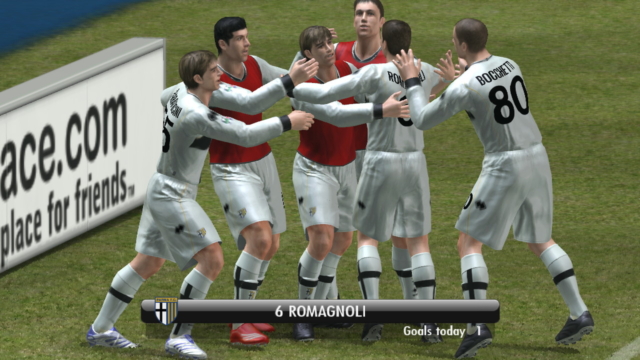
Pro Evolution Soccer 2008
Written by: Rik
Date posted: August 7, 2013
- Genre: Sport
- Developed by: Konami
- Published by: Konami
- Year released: 2007
- Our score: 9
At the time of writing, there are, essentially, two football games: Pro Evolution Soccer and FIFA. And each year, the same question is begged: which is better? When PES was king, the reviews would usually say that FIFA was improving and getting closer. I hadn’t been a regular FIFA player since I first played ISS Pro Evolution on the PSX, but I never really believed those reviews (and based on my recent experiences with the series, I’d still take them with a pinch of salt) and certainly never thought that one day PES would be overthrown.
Ultimately, of course, the critical consensus switched its allegiance to the EA behemoth, leaving PES to accept the empty platitudes and lower marks (and sales). Like many others, I stayed loyal to the series for a while, not least because EA didn’t bother to convert the 360/PS3 version of their new champion to PC, but ultimately, it was hard to avoid the conclusion that PES had seriously lost its way.
Opinions differ, of course (as a quick search for ‘worst PES game’ in Google will indicate) but I certainly have the impression that for many, PES 2008 is where the rot first set in. On PS2, PES was the best, but following the leap to the next generation of hardware, it started to fall behind and has spent all its time since trying to catch up. I agree that there have been some pretty awful PES games in recent years, but I don’t think that this is one of them.
One of the expressions you often hear in retro circles is, “Oh, I’d love a modern version of this with updated graphics” – although whether the person in question would actually love that is open to debate. Similarly, PES players have been known to forlornly pine for one of the old PS2 games (usually PES 5) to be spruced up and re-released, yet complain bitterly about PES 2008, which, for my money, is pretty much what they’ve been asking for.
Yes, PES 2008 remains fundamentally the same as many previous games in the series, and much of what I wrote here still applies. There’s the odd tweak here and there, and one or two new features, but the fact is, if you’d been cryogenically frozen in 2004 and defrosted in 2007, you’d have had no problems picking up this game and working it out.
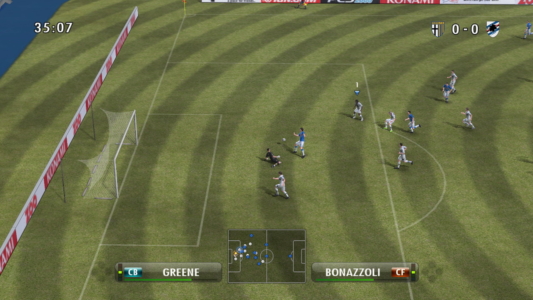
The keepers make a lot of saves with their body, which is just as well, seeing as they’re not so good with their hands.
And I suppose that was part of the problem when it was released: PES 2008 is the same old PES in so many ways. Not only have Konami not ripped things up and started again, they haven’t even fixed many of the issues that existed in previous incarnations. Free kicks and penalties are still very hit-and-miss; the labyrinthine tactical options remain baffling and yet can still be safely ignored; licensing for many of the top teams (especially in England) is still missing; and in general the presentation is a little lacking. Graphically, things have improved, but on the sound front, the crowd remain rather distant; the commentary team have changed but they still churn out the same rubbish (John Champion veers dangerously close to Alan Partridge territory when he implores the player to “treat the ball as a friend”, while Mark Lawrenson sounds more bored than he does on TV, which really is saying something); and the music is so bizarre it needs its own side-feature.
What’s more, there are new problems. Goalkeepers seem to make a habit of letting the ball slip from their grasp, while their defensive colleagues have a propensity for smashing the ball into their own goal while attempting a clearance. For some reason, you can’t select kits when you’re playing in the Master League, a fairly minor (albeit unfathomable) omission if the computer was able to detect when the teams were wearing exactly the same kit, but it isn’t and you’ll occasionally, and unavoidably, find yourself having to play very cautiously while squinting at the screen to pinpoint your own team-mates. The radar can be of some help here, although that’s subject to some random colour choices of its own.
The main change though, isn’t any of those, nor is it any of the things trumpeted on the back of the box – which, incidentally, amount to: diving (I was too slow-witted to use it effectively, and it’s not massively interesting as a feature anyway); UNIQUE TEAMVISION ™ (the AI apparently adapts to the way you play, I don’t think you can tell either way); and the ability to scan your face onto a player (see picture of my friend PG attached). No, it’s more a general feeling that something’s been lost. The game’s faster now, and dribbling is more effective, allowing quick and/or tricky players to dance past defences with greater ease, and the measured feeling that PES always had seems to have diminished, with the ball pinging around all over the place at 100 miles an hour. Once, you really felt and believed that PES was the ultimate football game, but yet with what amounts to only a few changes, it suddenly no longer feels like that.
And yet. Hidden deep in the bowels of the menu system, there’s an option that tots up all your stats since you installed the game. It’s interesting to note the win/loss ratio, and some of the other bits and bobs, especially if you only realised it was there once you’d had the game on your PC for about five years, but the most shocking stat was the one which told me how much time I’d spent playing the game. 146 hours. Now, that might not be a lot in your world of goblin botherers and dragon riding, but it’s still a rather significant amount of time. And none of that was in multiplayer, either.
The single-player game in previous PES games was a challenge, and it could be fun, but it seemed to be characterised by an ongoing battle against the goalless draw. Even at the highest difficulty setting, many teams seemed to carry little attacking threat and were content to just frustrate you (until you started to lose your rag and got careless, in which case they might decide to send you over the edge with a sneaky late winner). That’s not the case here – the computer will score and it will beat you, sometimes heavily. But even if you go behind, there’s not the sense, as in previous games, that you’re destined to get nothing out of a match – you can get back into it, too. You feel like you’re getting more of a game out of the opposition, rather than just having things made harder for you artificially.
As noted, it’s also now easier to do something exciting with the ball, to dribble past defenders, burst into space, or create an opportunity in the penalty area. Yes, goals are meant to be hard to come by, but occasionally in the past it felt like they were a little too hard to come by. The nimble fingered may well be able to pull off ridiculous combinations of dummies and feints or waltz past all 11 opposition players, but for those more aged and arthritic of hand such as myself, it doesn’t hurt to make it a bit easier to beat a man. In short, the single-player game has received a much-needed injection of excitement and seems to provide a more balanced experience as a result. I have a feeling that not everyone will agree with this, and I understand why, but believe me, I’ve played all of the games for long enough to be satisfied with this conclusion.
As ever, the bulk of the fun remains in Master League mode. The early stages are a little like the Europa League, in which you seem to play an interminable number of matches against increasingly obscure teams from the less high-profile leagues, before ultimately graduating to an approximation of one of the major European top divisions. From there, you can go back into European competition by finishing at or around the top of your league. And of course, while you’re doing this you also need to maintain your squad, manage their wages, and sell and sign players.
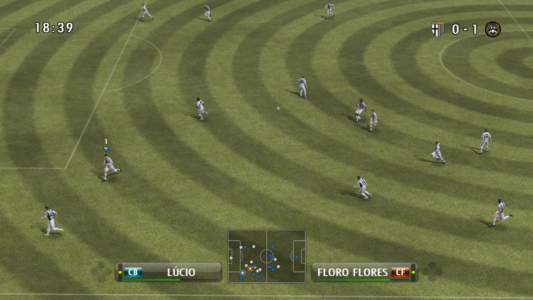
Parma, in their home strip of white and black, take on Siena, in their home strip of white and black. It’s not a great game for the neutral, Clive.
As with the venerable Championship/Football Manager series, it’s nice to have all the proper teams and line-ups to start with, but it ultimately doesn’t matter, as you soon become immersed in the game world to the extent that it becomes a parallel reality: seeing players that played for you in previous games now turning out for other sides (Gilardino! Frey! J’accuse!) seems like a betrayal, as does the impromptu Wikipedia search that reveals your star midfielder had little impact on your team in real life, and drifted away from the sport. The main pleasure is in starting with a fairly average team (hello again, Parma) and building it up through shrewd use of the transfer market and development of younger players.
It’s a genuine balancing act at the start – you’re heavily reliant on your one or two most talented attacking players, and risk running them into the ground despite their dwindling energy levels, because you don’t have the back-up talent to win games. Equally, funds for new signings will be tight, and not many players will be interested in coming, and so your early decisions in the transfer market are crucial. As you earn transfer points by winning games, you can buy based on future results and hope that you’ll play well enough to pay the wage bill at the end of the season, but if you don’t, it’s game over.
As time goes by, your youngsters’ stats will develop, while older players will start to become less effective. One of the series’ strengths is that you can really feel and observe different players’ attributes out on the pitch, and, stats aside, you can tell when a young player is starting to come along and an older one needs to be put out to pasture. For the first time, I actually made note of an influential opposition attacker (and not someone famous or well-known) and then signed him based on his performances against me – he turned out well, too.
If I had a criticism, it would be that, even on the hardest settings, it’s a little too easy to sign decent players. You can scout and negotiate all you want, but if you’re happy to target youth and out-of-contract players and those who are ‘open to negotiation’ you’ll still be able to pick up some handy signings. Another slightly iffy area is the way that some youngsters, over time, develop into gods with superhuman stats. In one of my games, Manchester City misfit Rolando Bianchi managed to develop from a fairly average centre forward at the start to the best attacker in world football after around four or five seasons. If you’re smart with your signings, then you’ll soon have a whole team of stat-tastic stars, and from then on the game lacks some of the romance of the early struggles (I lost my first four matches with Parma, then went on a stonking run of around 10 straight wins towards the end of the season, and missed out on promotion by a single point – it was genuinely rather exciting). Still, I guess you can always start out again if it gets too easy.I understand why people were disappointed with PES 2008 when it came out. It offered very little to the seasoned player except the annual coat of paint and an HD upgrade, and the tweaks to the gameplay seemed to come at the expense of the realism the series had always been known for. It’s sloppy and rough around the edges in places, and probably does lack that feeling of being a ‘classic’. But despite its flaws, it’s a hell of a game, and boasts possibly the most enjoyable single-player mode of the whole series. For me, PES 2008 isn’t where it all started to go wrong, it’s more of a closing of a chapter – the last hurrah for the PES of old.

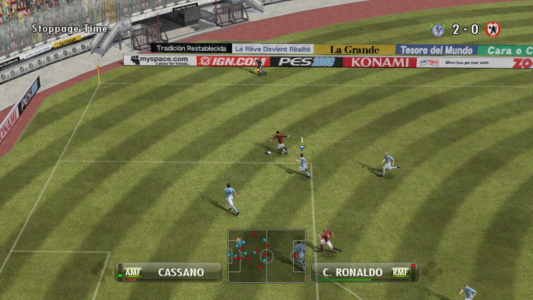
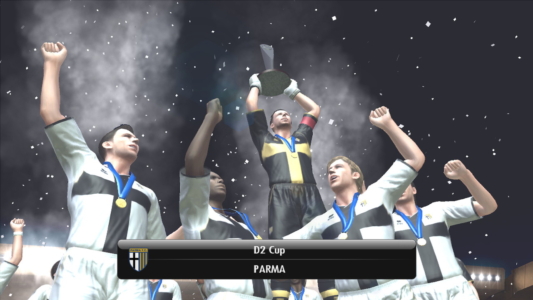
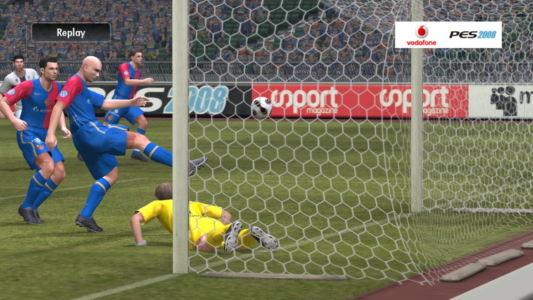
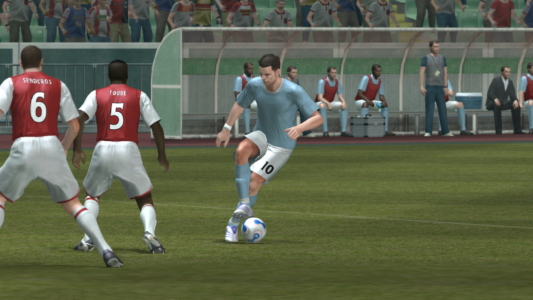

 Posts
Posts